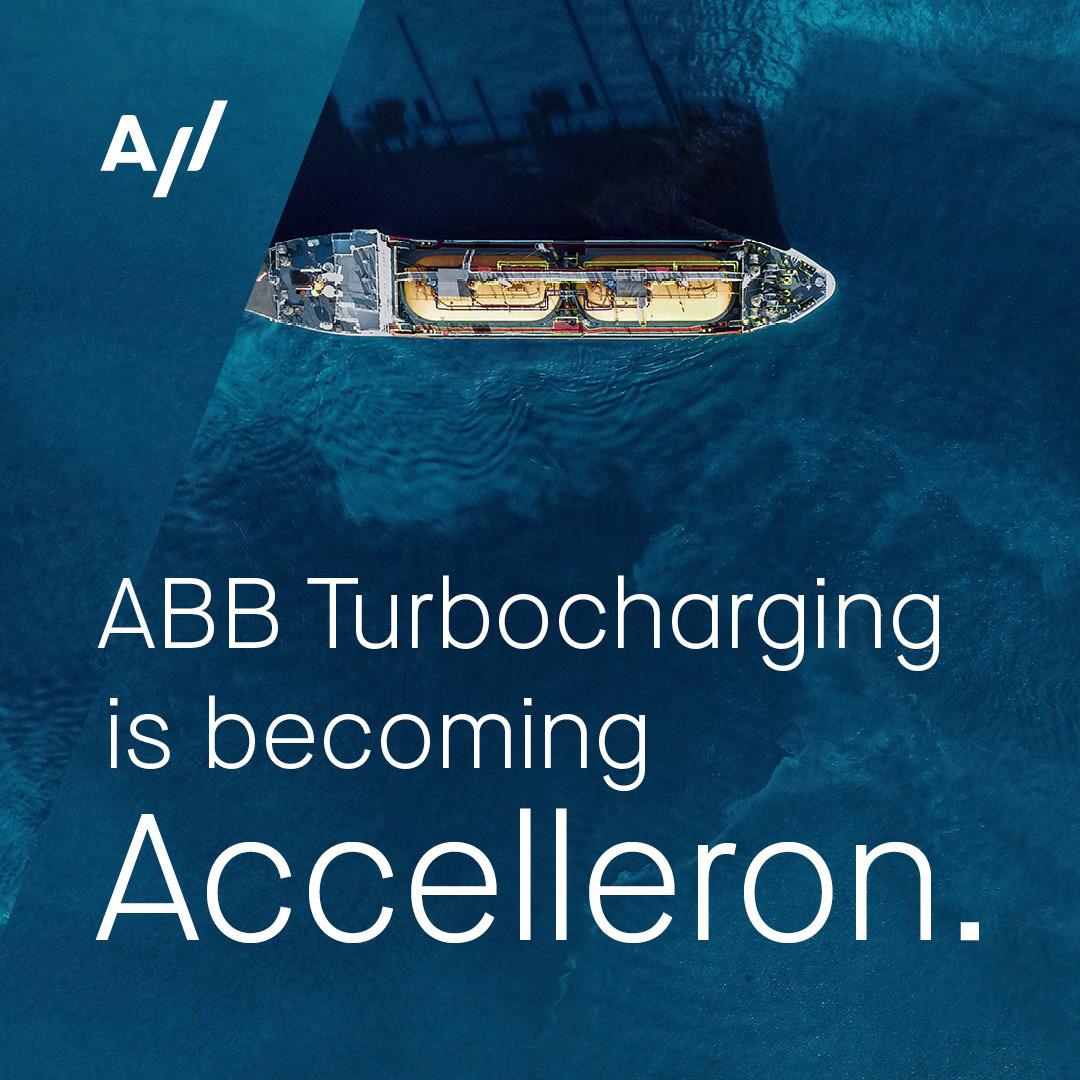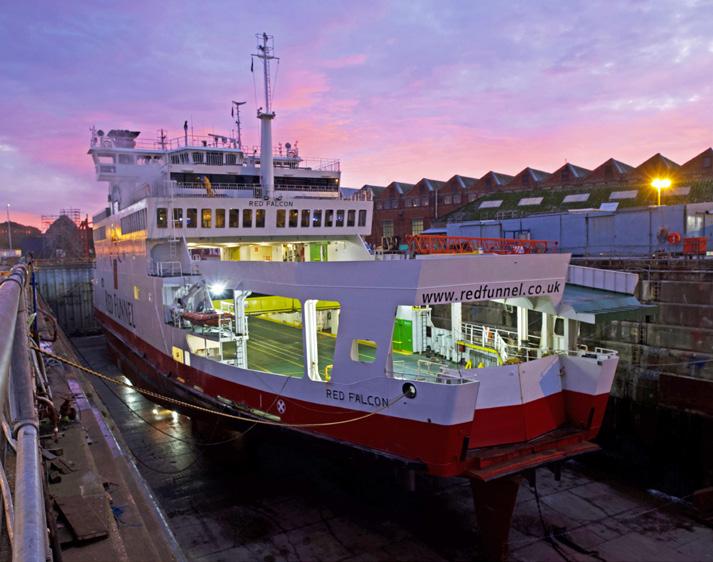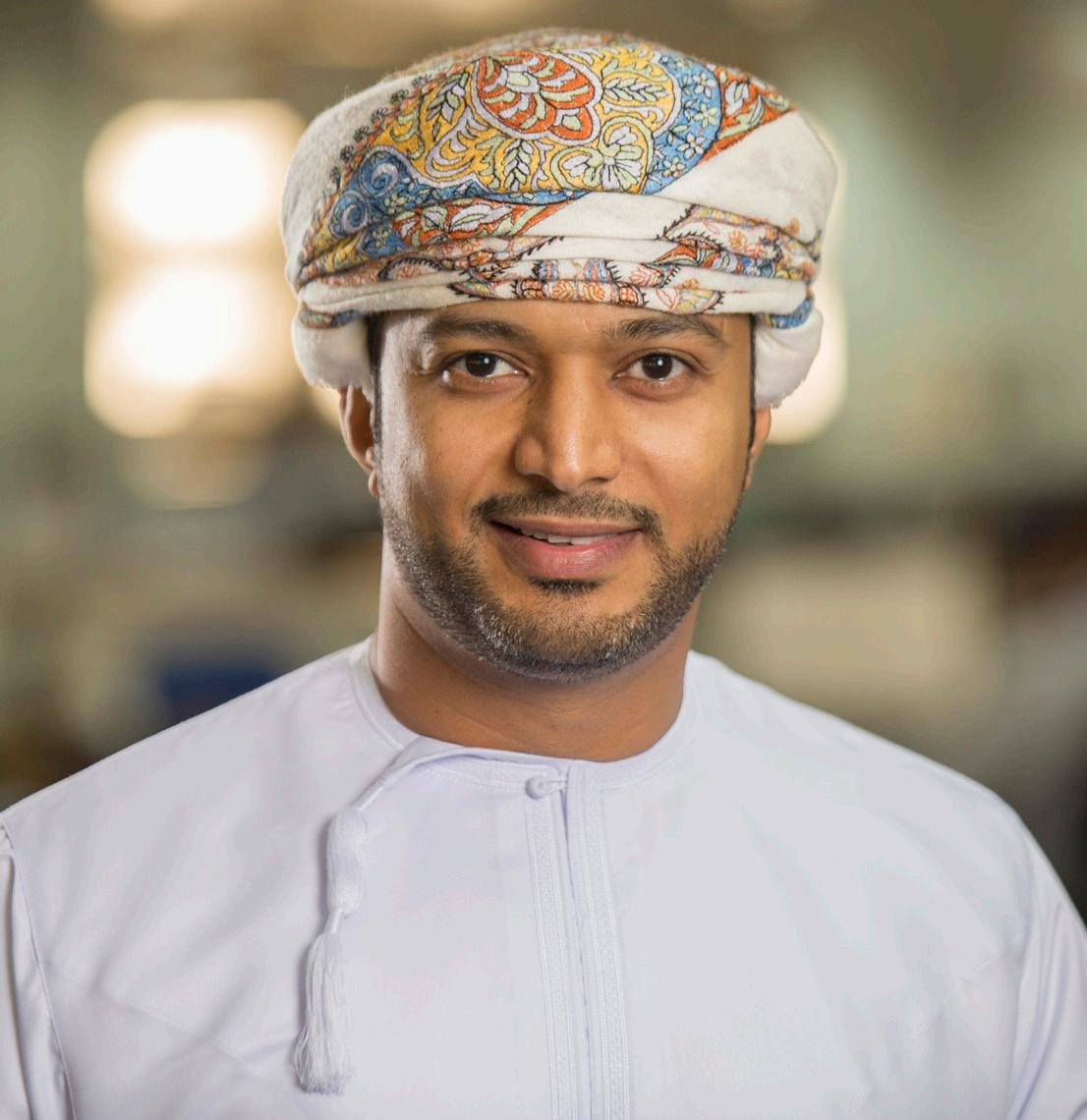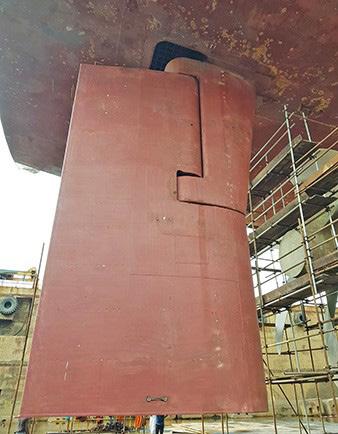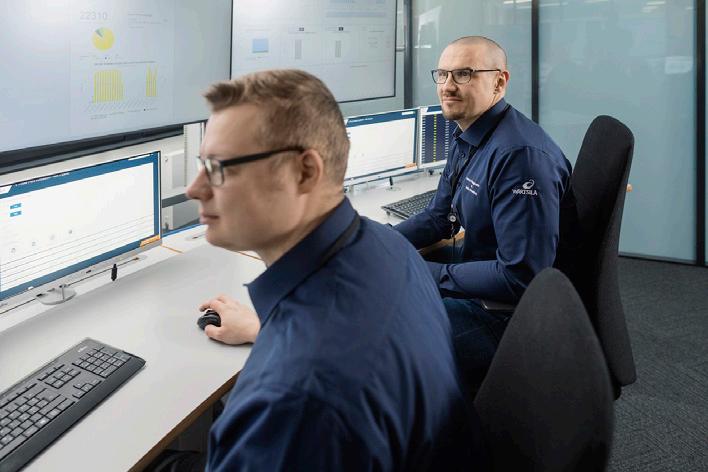
21 minute read
Offshore
HMC has renewed its LTSSP with Kongsberg Digital for an additional five years, ensuring on-going support teamed with state-of-the-art simulation for their training and digital twin operations
Heerema renews contract with Kongsberg Digital
Advertisement
Norway’s Kongsberg Digital has confirmed that Heerema Marine Contractors (HMC) has renewed its Long-Term System Support Program (LTSSP) contract with the company for another five years. The LTSSP is in support of a K-Sim Offshore Crane simulation system, which features digital twins of HMC’s semisubmersible construction vessels, ships and barges. HMC’s simulation centre is located at the HMC headquarters in Leiden, the Netherlands.
Renewal of the LTSSP ensures Kongsberg Digital’s continued commitment to maintaining Heerema’s simulators at the leading edge of available technology, from hardware upgrades through to additional ship models, library objects and equipment models. Installed in 2015 as one of the world’s most advanced offshore heavy lift crane simulators, its usage ranges from confirming feasibility of new methods and equipment to optimising efficiency and safety performance for current execution methods.
“By renewing this LTSSP we are ensuring that our clients, offshore crew and project teams continue to benefit from the most advanced simulation-based training and project preparation on the market, simulating real-world scenarios,” comments Jan Pieter de Vries, Manager Simulations and Visual Products, HMC Academy. “Kongsberg Digital has proved a competent partner, working in close collaboration with the team here at HMC to ensure that training and simulation needs are met. We are pleased to confirm our on-going relationship.”
Heerema’s simulator platform was developed specifically by Kongsberg Digital to meet Heerema’s requirements. The Simulation Centre is a real-time offshore environment where offshore crew and project teams examine all project aspects and associated risks. It includes two offshore crane operator domes and a bridge with K-Sim DP simulator, based on the same Kongsberg Maritime K-Pos DP systems used on HMC’s vessels. Detailed models of Heerema’s SSCVs, heavy lift vessel, tugs and barges ensure realistic scenarios and enable detailed pre-mission training for heavy-lift projects.

The Harvey Blue-Sea
ABS awarded ABS notation
A pair of Harvey Gulf International Marineowned OSVs has been awarded the ABS SUSTAIN 1 notation recognising how their design and operation is aligned with UN Sustainable Development Goals (UNSDGs). To earn the notation, the Harvey Blue-Sea and Harvey Sub-Sea were among 12 of the Harvey Gulf fleet evaluated by ABS for their performance against six of the UNSDG’s criteria. The remaining 10 vessels are also being considered for Sustain notations.
The ABS Sustain notations demonstrate adherence to certain UNSDGs related to vessel design, outfitting and layout that can be controlled, measured and assessed. They establish a pathway for sustainability certification and reporting.
“The notations recognise forward-looking operators’ commitment to supporting the UNSDGs and to maintaining a sustainable fleet. It reflects the operators’ commitment to a holistic as opposed to an incremental approach toward Sustainability. I am delighted that we are able to support Harvey Gulf on its sustainability journey and to help them demonstrate to the industry their environmentally sound approach,” said Georgios Plevrakis, ABS Director, Global Sustainability.
Huisman contract with DSME
Rotterdam’s Huisman has announced the signing of a contract with South Korea’s Daewoo Shipbuilding and Marine Engineering (DSME) for delivery of another 2,600 tonnes Leg Encircling Crane (LEC). This follows a previous order, in July last year (2021), for a similar crane. This crane will be installed on the second Wind Turbine Installation Vessel ordered by Eneti and constructed by DSME.
The LEC will be outfitted with a 155 m boom, which, similar to the first crane, was extended to reach an unparalleled lifting height of 174 m above deck. This brings the hook height to approximately 215 m above LAT. This, combined with its 2,600 tonnes lifting capacity, gives the crane a degree of futureproofing,

An artist’s impression of Huisman’s LEC
preparing it for handling the next generation of wind turbine, with up to 20 MW capacity.
Huisman has designed its LECs to meet the requirements of the continually developing offshore renewables sector. The cranes are lightweight, have high positioning accuracy and are highly energy efficient, contributing to a reduced emissions footprint during operations. The crane features a small tail swing, offering optimal deck space. The theme of efficiency is continued in the design of the slew bearing. Its construction in multiple segments ensures ease of inspection and maintenance. The entire construction and the majority of the main equipment are securely housed, offering protection from the harsh marine environment for utmost reliability and low maintenance. Huisman will carry out the design, engineering and construction of the LEC, including its pedestal adapter.
LEC Features: • A fully electrically driven system, resulting in high positioning accuracy, efficient energy use, reduced maintenance and high reliability • In-house developed slew bearing system, providing highly reliable and accurate positioning of the crane • A unique Lambda boom design ensuring a lightweight and stiff design, limiting motions at the crane tip • Small tail swing allowing for optimised utilisation of free deck space
Wärtsilä introduces CFD modelling as a dp solution
Finland’s Wärtsilä has introduced its latest development based on the applied Computational Fluid Dynamics (CFD) modelling to enable the accurate and speedy configuration of thrusters and other propulsion systems, to deliver the optimal dynamic positioning (dp) solution. The new Wärtsilä OPTI-DP Engagement Tool, which has been verified by DNV has been developed in response to the increasing need for efficient high-performance station keeping and manoeuvrability as offshore operations become more complex.
Conventional methods for assessing accurate DP capability calculations have become increasingly challenging as offshore operations move further from shore, and the vessels serving them become larger and more complex. OPTIDP allows the simulation of environmental operating conditions, with independent wind, wave and current directions, if desired, plus the ability to simulate multiple failures. The Wärtsilä solution considers all details of a vessel’s thruster and propulsion performance, including the benefits of the 8-degree tilted thruster solutions, and utilises CFD results to deliver an accurate analysis.
Any negative impact from interaction between the thrusters, other propulsion systems and, for example, jack-up legs can be minimised. The system can prescribe any number of forbidden zones to indicate unwanted interaction between thrusters. The results of performance evaluations are presented in clear, thrust-utilisation polar plots for given environmental conditions or maximum


Wärtsilä OPTI-DP Engagement Tool - High performance propulsion configuration
acceptable wind speed plots.
“The independent DNV verification found that the Wärtsilä OPTI-DP Engagement Tool meets the requirements of the DNV standard ST-0111 Level 1, Level 2, and Level 2-site without thrust ventilation loss impact. These set requirements for analysing the station-keeping capability of a vessel in DP operations based on the static balance of environmental forces and the vessel’s actuator forces,” says Luca Pivano, Principal Specialist DP Simulations, Control Systems and Cybernetics Advisory at DNV.
“The OPTI-DP Engagement Tool is a valuable breakthrough that will improve the safety and efficiency of vessels that require efficient and safe DP capability. By allowing an optimised propulsion configuration based on thrust performance, we can now accurately predict the station keeping capability of a vessel, which allows for maximum utilisation of the vessel operating in challenging weather conditions,” says Lauri Tiainen, Director, Thrusters & Propulsion Control Systems, Wärtsilä Marine Power.
The solution allows the implementation of azimuth thrusters, tunnel thrusters, and propellerrudder combinations, with results available in hours rather than weeks. The delivered accuracy and efficiency gains are complemented with reduced investment and operational costs.
DEME acquires installation vessel
Belgium’s DEME has entered into an agreement with Norwegian shipping company Eidesvik to acquire the DP3 offshore installation vessel Viking Neptun. Representing a substantial investment, this move highlights DEME’s commitment to its customers, and supports the continued growth of the offshore wind industry. This latest addition to its vessel fleet also confirms DEME’s mission to build futureproof, sustainable and environmentally friendly operations.
Built to the highest Norwegian quality standards, Viking Neptun currently has a turntable capable of handling 4,500 tonnes of cables below deck, but DEME will further boost its capacity by adding a second, 7,000 tonne cable turntable on deck. The addition of the vessel is in line with DEME’s strategy to deploy the most versatile and high-tech fleet in the industry. DEME already operates the pioneering, DP3 cable installation vessel Living Stone, renowned as one of the fastest and most efficient vessels in the cable installation sector.
Continuing DEME’s efforts to provide a future-proof, sustainable fleet, the vessel is fully compliant with the latest emission standards and features the latest environmental technology, including a battery pack for ‘best in-class’ fuel efficiency and more sustainable operations. The 145 m long vessel is also equipped with a large, unobstructed deck and a 400 tonne Active Heave Compensated Knuckle Boom crane, which also makes Viking Neptun ideal for the construction of floating wind farms.
Hugo Bouvy, Managing Director DEME Offshore, comments, “DEME is always keen to anticipate the future demands of our clients and to support them in their growth. Acquiring a second, large cable-laying vessel ensures that we are ready to serve their needs now and, in the future, and that we take a proactive role in helping to facilitate the energy transition. Since its introduction, our DP3 offshore installation vessel Living Stone has made its mark on the industry, with unrivalled capabilities. We are sure that Viking Neptun will have an equally impressive career in the DEME fleet and it underlines our efforts to meet and exceed our customers’ requirements. At DEME, we also share Eidesvik’s team focus on pushing for more environmentally friendly operations and we will also investigate opportunities for further co-operation between our two companies.” The Viking Neptun is set to join the DEME fleet in the last quarter of 2022.

The Viking Neptun
Norwind to use KM equipment on-board CSOVs
The new ship-owning company – Norway’s Norwind Offshore will fit Kongsberg Maritime (KM) equipment to its two new Commissioning Service Operations Vessels (CSOVs), to be built by Norway’s VARD. KM’s scope of delivery encompasses a combination of systems which will enable the operator to maximise operational windows whilst minimising overall energy consumption.
Key to this is the propulsion technology, which for the CSOVs will include new permanent magnet (PM) PMAZ 2600PM azimuth thrusters, PM tunnel thrusters and a retractable azimuth thruster. The return of investment is greater propulsion efficiency and manoeuvrability with reduced operational noise, lower emissions and compact dimensions.
These units are part of an environmentallyfocused range of propulsion units developed by KONGSBERG over the last decade, all based on the company’s in-house PM technology. With only one rotating component in the underwater unit, low oil volume and no requirement for

KM is to supply a combination of systems to Norwind Offshore for installation on its two new CSOVs, due for construction at the VARD shipyard in Norway
lubrication pumps or inboard cooling systems, PM thrusters experience reduced wear and tear and consequently deliver substantial savings in lifecycle cost. They also benefit from significant reductions in energy consumption, emissions and oil spill risk when compared with conventional azimuth thrusters and are designed to meet stringent noise and vibration requirements, both on-board the vessel and regarding emissions to sea (URN).
“We are investing in this state-of-the-art technology from KM in full confidence that it will pay off in the long term,” says Svein Leon Aure, CEO of Norwind Offshore. “Our operational expenditures will be considerably reduced in comparison to using conventional thrusters, and the same goes for our environmental footprint. This provides us with purpose-built vessels, designed for the future of advanced maritime operations in the offshore wind market.”
The first of the new CSOVs of VARD 4 19 design will be delivered from VARD in 2Q 2023. The second vessel is scheduled for delivery in the third quarter of 2024.
DLM to supply technology for cable testing tank
Dynamic Load Monitoring (DLM), of Southampton, UK, has provided a custom data logger and subsea measuring technology for use in a new tank where cable protection systems are tested. Darlington, UK-based Subsea Innovation Limited, a designer of innovative subsea and offshore equipment, will primarily use the equipment for testing and verifying their in-house designed subsea equipment such as pipeline repair systems (clamps and connectors), hang-off systems, and other bespoke subsea and offshore equipment.
It will also be used for internal testing for Subsea Innovation’s purpose-designed and built submerged wear test rig. The company also maintains and manufactures deck equipment for cable lay vessels.
This is the second major order that DLM has delivered to the company recently, having provided two bespoke SORJ monitoring systems that were installed on subsea bend

The DLM logger and subsea measuring technology
stiffeners at an offshore wind farm. However, DLM is increasingly responding to demand for bespoke and standard solutions from similar maritime technology and marine electronics companies.
Martin Halford, managing director at DLM, said, “We’re putting together systems like this with increasing regularity—incorporating load cells with other instrumentation and sensors. However, no two such jobs are the same. We start with the client’s problem, review what off-the-shelf instrumentation and sensors are available, and then customise the final package accordingly based on the environment, subsea or otherwise, and demands of the application.” In this instance, a custom data logger takes inputs from several sensors, initially feeding back information on load, rotation, and temperature. More sensors can be added to an expandable system should the need arise in the future. A stainless steel enclosure is mounted in Subsea Innovation’s workshop next to the test tank, which remains in construction. Within the enclosure, the logged data is collated and logged again as a package in a Programmable Logic Controller (PLC) on a memory card.
An Ethernet port, meanwhile, enables the user to plug in a PC to download the data periodically. Halford explained, “You can get a remote view on a web browser of the HMI [human-machine interface] screen to see both live values from the sensors and also download the data logs.”
Integral to the system will be an S-cell load cell from DLM’s standard range, which will be submerged in the tank at a depth of approximately 1m. The load cell is 250 kg capacity and will measure in tension and compression. This is the lowest available capacity of a standard range than reaches up to 20 tonne capacity and boasts welded covers, stainless steel construction, sealing to IP68, and high accuracy. It is suitable for use on test stands, to take measurements during certification, and in vessel and tank weighing applications, in addition to retrofit in original equipment manufacturer (OEM) technologies and machinery.
Other standard equipment in this order includes proximity and other sensors, and thermocouples, used for measuring temperature.

The FPSO BW Joko Tole
BW Offshore sells FPSO to Indonesia
BW Offshore has signed an agreement for the sale of the FPSO BW Joko Tole to PT Bahari Inti Tanker and PT Cahaya Haluan Pasifik, both of which are Indonesian companies, in consortium with PT Buana Lintas Lautan Tbk, a company publicly listed in Indonesia. The consortium will continue to operate the FPSO under the lease contract with Kangean Energy Indonesia. The transaction is part of BW Offshore’s strategy to transition to floating energy infrastructure investments. The sale will free up over US$50m of liquidity, comprising of net sale proceeds of $42.5m and the release of $9m of working capital upon closing. There is no debt attached to the FPSO. The Company expects to book a loss from the transaction of around $23m and a tax expense of approximately $12m from the write-down of a related deferred tax asset. These non-cash items will be recorded in the accounts for the fourth quarter of 2021.
BW Offshore will provide transition services for a period of up to four months after closing to ensure safe and uninterrupted transfer of operations including the local organisation operating the FPSO to the new buyer. The BW Joko Tole is a gas producing FPSO operating on the TSB field offshore Indonesia.
Offshore electrical power from MSS
Denmark’s Maersk Supply Service’s (MSS) is pioneering a new company will deliver offshore electric charging solutions to vessels at ports, hubs and offshore energy operations. Stillstrom, meaning ‘quiet power’ in Danish, is an earlystage technology spin-out, whose full-scale product launch will be the first-to-market in offshore charging, enabling idle vessels to power from clean electricity.
Offshore charging for idle vessels is critical to facilitating the decarbonisation of the maritime industry, since it allows vessel owners to replace fossil fuels with electricity while being safely moored to the charging buoy.
The first full-scale charging buoy will, as previously announced, be demonstrated with offshore wind leader Ørsted in the third quarter of 2022. The power buoy will supply overnight power to one of Ørsted’s Service Operations Vessels (SOV), thereby supporting Ørsted’s target of climate-neutral operations in 2025. Ørsted will be responsible for the grid integration of the charging buoy.
Ørsted intends to make publicly available any intellectual property generated during the design of the buoy’s integration into the offshore wind asset, to maximise the potential uptake of this carbon-reducing innovation across the offshore wind sector.
The charging buoy itself is large enough to charge an SOV-sized battery- or hybrid-electric vessel. The same solution will be scaled and adapted to supply power to larger vessels, enabling vessels of all sizes to turn off their engines when lying idle. By substituting fossilbased fuels with green electricity, virtually all emissions and noise pollution are eliminated while the buoy is in use.
“Stillstrom is part of our commitment to solving the energy challenges of tomorrow. By investing in this ocean cleantech space at an early stage, we can help lead the green transition of the maritime industry. Stillstrom has been developed within MSS and the timing is right to create a venture that will be focused on delivering offshore charging solutions,” says Steen S. Karstensen, CEO of MSS.
“Our vision at Stillstrom is to enable maritime decarbonisation, by providing the infrastructure that will allow vessels to charge from clean
energy when idle offshore. The mission is to remove 5.5m tonnes of CO2 within five years of commercial rollout, additionally eliminating particulate matter, NOx, and SOx,” says Sebastian Klasterer Toft, Venture Programme Manager at MSS.
Stillstrom is fully owned by MSS and has received funding support from the Danish Maritime Fund and EUDP.
Meanwhile, MSS has been awarded an integrated solutions contract by Shell Brasil, for a station-keeping assignment during the removal of the emergency Gas Lift Riser on the FPSO Fluminense. The scope includes responsibility for the station keeping, including vessels, heading control procedures, towmasters, survey equipment and deck crew for the FPSO to manage turret operations.
Two MSS anchor-handlers, Maersk Launcher and Maersk Lancer, are assisting with the offshore element of the contract, commencing their charter from Rio de Janeiro.
With this contract, Maersk Supply Service is consolidating its position in the Brazilian market where it won the large Mero2 project last year, which will be executed during the course of 2022. It comes as MSS continues to establish its portfolio as an integrated solutions provider, combining in-house project management and technical expertise with the flexibility of a versatile fleet.

The Stillstrom system
FPSO work for Royston
UK’s Royston Marine has completed the overhaul of a diesel power plant system on-board an Altera Infrastructure operated cylindrical FPSO platform. Drawing on its extensive capabilities and resources, engineers


The FPSO Hummingbird Spirit

completed the 24,000 running hours service work on a Mitsubishi S12U engine installed onboard the 60 m diameter length Hummingbird Spirit, currently operating in the Chestnut Field in the Central North Sea.
The work was carried out in several phases and involved engine disassembly with key components shipped to Royston’s Northeast workshop where they were overhauled as part of the second phase of the job.
Main engine work included repairs to the crankshaft, installation of new turbochargers and air and oil coolers alongside checks and repairs to cylinder heads, liners, bearings, connecting rods and pistons. The final phase saw the completion of the work, reinstallation, commissioning and comprehensive engine load testing.
Shaun Cairns, Royston’s operations manager, said, “This latest Hummingbird Spirit contract shows our experience, expertise and capabilities in comprehensive engine health check, diagnostics and repair work. Regardless of the service requirements and condition of a vessel’s power plants, we continue to deliver a fast, efficient service together with added value expertise.”
Owned by Teekay but operated by Altera Infrastructure, Hummingbird Spirit is a cylindrical SSP300 vessel with offshore tanker offloading facilities and has an oil export capacity of 270,000 bbls on FPSO or 220,000 bbls on an offload tanker.
HOS completes Osbit project
Sunderland based, Hydraulic & Offshore Supplies (HOS) has successfully completed a project with subsea engineering and technology company, Osbit. The project included completing the manufacture, installation and pressure testing of over 350 flexible hose assemblies to a globally innovative piece of technology developed by FTAI Ocean and Osbit. This will be used to support energy transition through extending the life of existing subsea oil & gas wells.
HOS managing director Don Fenwick, commented, “We were delighted to work with Osbit and FTAI Ocean on the project which showcases our team’s ability to meet the very highest quality and engineering standards. Our experienced and highly trained technicians and engineers completed the project on time and within budget and look forward to working on further related projects in the future.”
Three employees from HOS have successfully gained their hydraulic passports
Work and training on a HOS project

following training from the British Fluid Power Association’s training academy. Hose technicians, Emily Stronge-Taylor, Laura Fenwick and Joe Joyce all completed the Hose Assembly Skills Training two-day programme which was held at the company’s workshop on Sunderland’s riverside.
The course, which is carried out in both a classroom and shop floor environment brings delegates up to a sound level of hydraulic appreciation to enable them to develop into a quality hydraulic hose technician. Delivered by industry professionals, the course gives both the attendee and employer confidence that the correct methods and culture are being adopted and used, topics covered include understanding hose assemblies, contamination, installation and hose management.
Laura Fenwick, who has recently celebrated her first year with the company, commented, “It was great to take part in the training and further develop my hydraulic knowledge. I’m looking forward to putting this into practice and hopefully taking part in future training too. I’ve really enjoyed my first year with the company and really appreciate the emphasis they put on staff training and also making sure that we are always kept up to date with health, safety and sector knowledge.”
HOS has manufactured and supplied hose assemblies and fluid power products from their workshop in Sunderland for over 30 years therefore have many years’ experience within the industry with their customer base including national and international clients.
HOS Managing director, Don Fenwick, was delighted the three employees successfully passed the training, “In the fluid power, hydraulic and pneumatic industry, safety and quality is paramount which is why we are always keen to further develop our employee’s knowledge of our products and services.
There are dangers when working with hydraulics which is why work should only be carried out by qualified professionals. We’re delighted Emily, Laura and Joe enjoyed the training whilst also gaining valuable knowledge.”
It’s been a busy start to 2022 already for the HOS team as we took delivery of our new updated and enhanced hydraulics catalogue. The catalogue has been a staple of our product range for over 20 years - however, the new edition has been brought more into line with our specific hydraulic range. New features include increased product ranges, enhanced item descriptions, a specific focus on hydraulics and updated product specification pages.
Customers can also be assured the catalogue still consists of product favourites, easy to navigate sections, next day delivery on stock items and cost-effective pricing.
HOS director, Paul Taylor, was delighted the team could start the year by introducing the new catalogue, commenting, “We know many of our customers still rely on our hard copy catalogue and find this invaluable when purchasing for ship managers, vessels and marine procurement.
“With the enhanced features in this edition, we feel we’ve kept to our hydraulic roots while also assisting clients with more custom-made products. Along with the comprehensive catalogue, we also aid with hydraulic installations, repairs and servicing requirements and having over 30 years’ experience within the fluid power sector are here to provide support and advice where necessary.”
SORJ

TURN UNCERTAINTY


